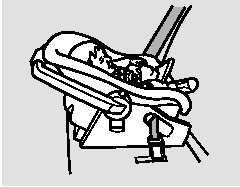Honda CR-V: Protecting Infants

Child Seat Type
An infant must be properly restrained in a rear-facing, reclining child seat until the child reaches the seat maker’s weight or height limit for the seat, and the child is at least one year old.
Only a rear-facing child seat provides proper support for a baby’s head, neck, and back.
Two types of seats may be used: a seat designed exclusively for infants, or a convertible seat used in the rearfacing, reclining mode.
Do not put a rear-facing child seat in a forward-facing position. If placed facing forward, an infant could be very seriously injured during a frontal collision.
Rear-facing Child Seat Placement
A rear-facing child seat can be placed in any seating position in the back seat, but not in the front. Never put a rear-facing child seat in the front seat.
If the passenger’s front airbag inflates, it can hit the back of the child seat with enough force to kill or seriously injure an infant.
When properly installed, a rearfacing child seat may prevent the driver or a front passenger from moving their seat as far back as recommended, or from locking their seat-back in the desired position.
It could also interfere with proper operation of the passenger’s advanced front airbag system.
In any of these situations, we strongly recommend that you install the child seat directly behind the front passenger’s seat, move the seat as far forward as needed, and leave it unoccupied. Or, you may wish to get a smaller rear-facing child seat.

Placing a rear-facing child seat in the front seat can result in serious injury or death during a crash.
Always place a rear-facing child seat in the back seat, not the front.

